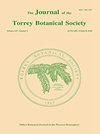Frost pockets on a level sand plain: Does variation in microclimate help maintain persistent vegetation patterns?2
IF 0.8
4区 生物学
Q4 PLANT SCIENCES
引用次数: 28
Abstract
tation patterns across broad geographic regions and areas of steep topography. However, few studies have evaluated the potential influences of local climatic variation on vegetation patterns or dynamics. We investigated the relationships between microclimatic variation, vegetation structure, and leaf phenology on a topographically level sand plain that is characterized by a forest mosaic with abrupt transitions to shrublands dominated by scrub oak (Quercus ilicifolia). The timing of bud break, leaf phenology, and height of scrub oak are strongly related to variation in temperature across the study site. Moderate maximum and minimum temperatures occur beneath forested canopies, whereas nearby shrublands experience frequent late-spring frosts and shorter frost-free growing seasons, resulting in chronic dieback of developing leaves, slow growth rates, and reduced stem height. Our results indicate that extreme radiational cooling in open areas on level, xeric sites may result in the development of 'frost pockets' similar to those that occur in topographical depressions and may contribute to slow establishment of a forest canopy after disturbance. Such frost-prone areas may have become more common as a result of historical cutting and burning and may contribute to the persistence of scrub oak stands that support several rare species and are high priorities for conservation.平坦沙地上的霜穴:小气候的变化有助于维持持久的植被模式吗?2
跨越广阔地理区域和陡峭地形区域的地理格局。然而,很少有研究评估了当地气候变化对植被格局或动态的潜在影响。我们研究了地形平坦的沙地平原上的小气候变化、植被结构和叶片物候之间的关系,该平原以森林马赛克为特征,突然过渡到以灌丛栎(栎)为主的灌木地。灌丛栎的芽断时间、叶片物候和高度与研究地点的温度变化密切相关。中等的最高和最低温度发生在森林冠层下,而附近的灌丛频繁出现晚春霜冻和较短的无霜生长季节,导致发育中的叶子慢性枯死,生长速度缓慢,茎高降低。我们的研究结果表明,在平坦、干燥的开阔地区,极端的辐射冷却可能导致与地形洼地类似的“霜袋”的发展,并可能导致扰动后森林冠层的缓慢建立。由于历史上的砍伐和焚烧,这种容易发生霜冻的地区可能变得更加普遍,并且可能有助于维持几种稀有物种的矮丛橡树林,这些矮丛橡树林是高度优先保护的。
本文章由计算机程序翻译,如有差异,请以英文原文为准。
求助全文
约1分钟内获得全文
求助全文
来源期刊
CiteScore
0.70
自引率
0.00%
发文量
16
审稿时长
>12 weeks
期刊介绍:
The Journal of the Torrey Botanical Society (until 1997 the Bulletin of the Torrey Botanical Club), the oldest botanical journal in the Americas, has as its primary goal the dissemination of scientific knowledge about plants (including thallopyhtes and fungi). It publishes basic research in all areas of plant biology, except horticulture, with an emphasis on research done in, and about plants of, the Western Hemisphere.

 求助内容:
求助内容: 应助结果提醒方式:
应助结果提醒方式:


